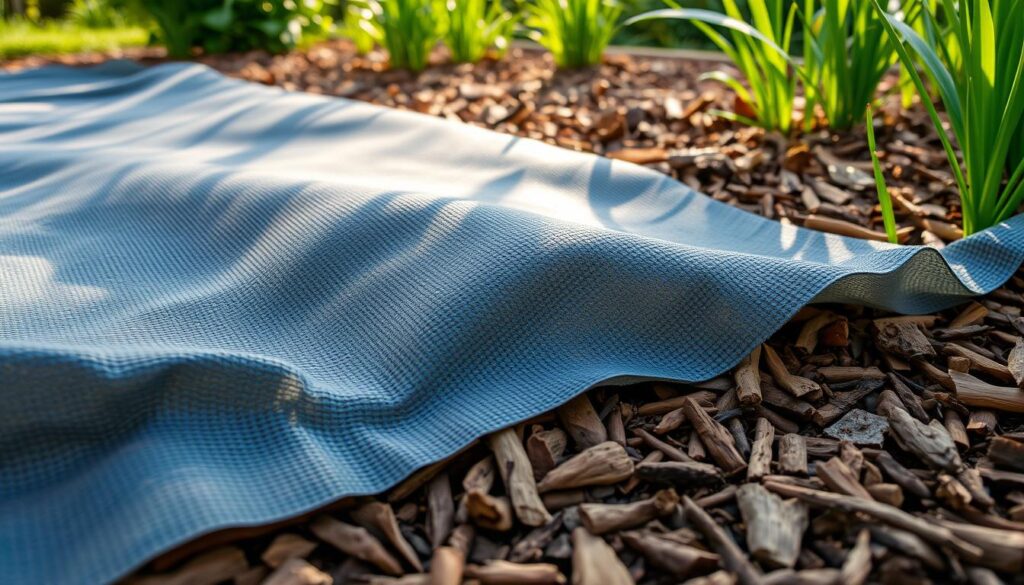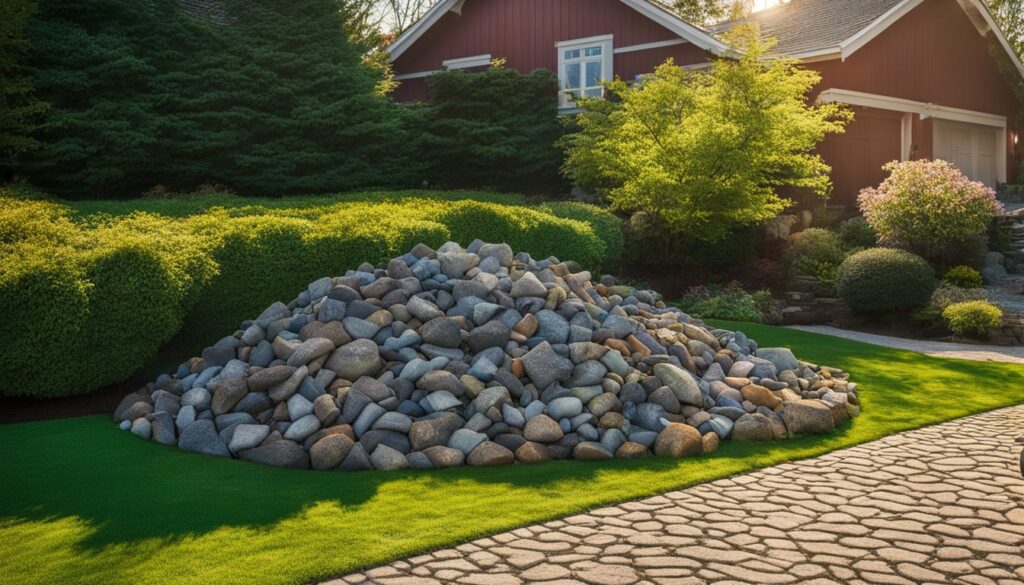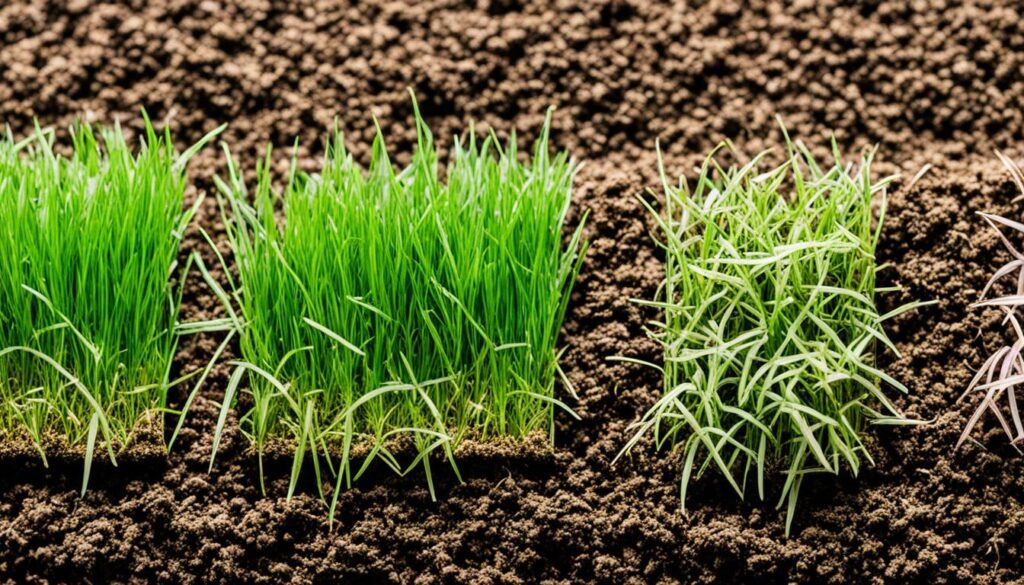Did you know that landscape fabric can cut water infiltration rates by up to 50 percent? This fact shows how important it is to pick the right materials for your garden. Some think using landscaping fabric over mulch helps with weed control and keeps gardens neat. But, the truth might surprise you.
Choosing whether to use landscaping fabric can greatly affect your garden’s health and look. Mulch can block sunlight and stop weeds, like three inches of shredded wood mulch that prevents weed seeds from germinating. But, adding landscaping fabric can block nutrient transfer and soil aeration. This might make weeding harder, as weeds can grow through the fabric to the soil below. For more on the good and bad of using landscaping fabric with mulch, check out this in-depth article.
Choosing the right landscaping materials can make your garden look great and stay healthy. Next, we’ll look closer at landscaping fabric, its uses, and what it means to use it over mulch.
Key Takeaways
- Landscaping fabric may significantly reduce water infiltration.
- Mulch can effectively block sunlight and suppress weeds, yet fabric changes its efficacy.
- Weeding can become more complicated when using landscaping fabric.
- Mulch needs time to break down for optimal soil health and nutrient addition.
- Five to seven years is a common timeframe for replacing mulch layers.
Introduction to Landscaping Fabric
Landscaping fabric is a special material that stops weeds but lets air and water through. It’s great for many gardening needs, acting as a weed barrier. Knowing how to use it can make your garden look better and work better.
What is Landscaping Fabric?
Landscaping fabric acts like a filter, keeping weeds away while helping with moisture and keeping soil temperature right. Good quality fabric can last up to 20 years if taken care of. It’s important to pick one that stands up to the sun and doesn’t tear easily.
To make sure it lasts, you should staple it down every 10 feet and overlap the pieces by at least 6 inches.
Common Uses of Landscaping Fabric
Landscaping fabric is very useful in gardens. I use it in flower beds and vegetable gardens to stop weeds. It helps keep plants looking good and healthy.
You can also put it under pathways and rock gardens to keep weeds out. But, you need to check on it regularly to keep it working well. Even with this fabric, you still need to look for weeds and make sure water can get through.
For more info on landscaping fabric, check out this article on its uses and.
Understanding Mulch: Benefits and Types
Mulch is key in gardening and landscaping. It helps with looks and soil health. Knowing about its benefits and types can improve my gardening.
What is Mulch and Why is it Important?
Mulch is a layer of material on the soil. It’s important for many reasons:
- Moisture retention: It keeps the soil moist, especially in hot weather.
- Weed suppression: A thick layer stops most weeds from growing, saving time on upkeep.
- Temperature moderation: Mulch acts as insulation, protecting roots from extreme heat and cold.
- Nutrient enhancement: Organic mulch breaks down and adds nutrients to the soil.
- Erosion control: It reduces soil erosion by softening raindrops, great for sloped areas.
Types of Mulch: Organic vs. Inorganic
There are two main types of mulch: organic and inorganic. The choice depends on my gardening needs.
- Organic mulch: Includes wood chips, straw, and grass clippings. It breaks down and adds nutrients to the soil, helping with structure and microbes.
- Inorganic mulch: Covers rubber mulch and landscape fabric. It controls weeds well but doesn’t feed the soil like organic mulch does.
Can You Put Landscaping Fabric Over Mulch?
Thinking about putting landscaping fabric over mulch brings up many points to consider. I’ve looked into both sides of the debate. This helps me decide the best way to keep weeds down and keep my garden healthy.
Arguments for Using Landscaping Fabric
One big reason to use landscaping fabric is it stops weeds from growing. Gardeners like how it keeps weeds away when put on bare soil right. It lets water move in and out but blocks sunlight, which is good in some cases.
Putting it under rubber mulch works even better by keeping soil moist. This fabric is also strong, lasting years with good materials like recycled ones.
Arguments Against Using Landscaping Fabric
There are also reasons not to use landscaping fabric. It might not work well under things like wood chips because they break down and let weeds grow. If put in wrong, it can hurt soil health by not letting air and nutrients in.
I’ve seen that keeping it up is key since it wears out and stops working against weeds. It also makes planting later harder and can slow down plants you want. Many gardeners prefer other ways to fight weeds, like natural gardens or cover crops, without using fabric.
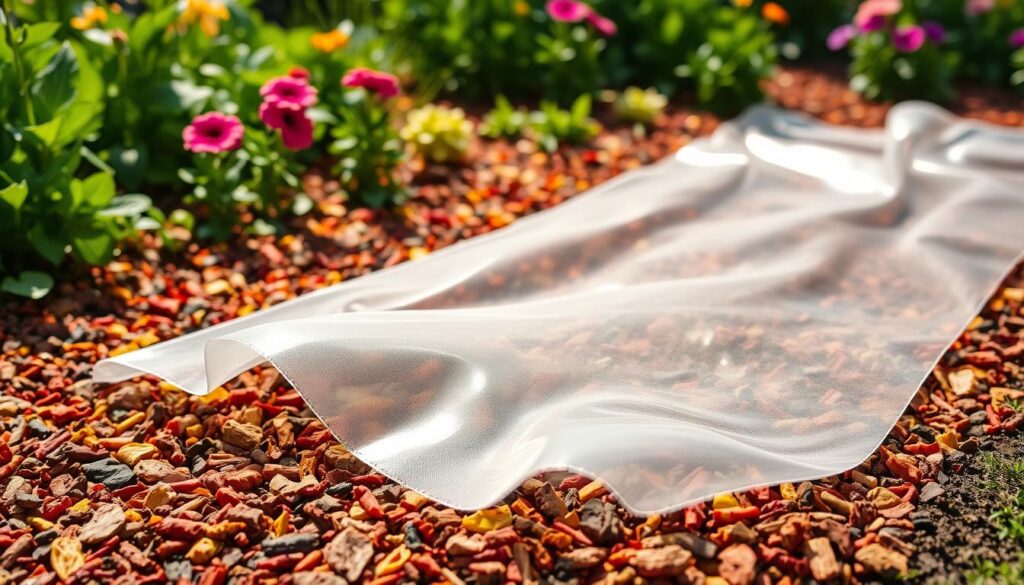
| Aspect | Arguments For | Arguments Against |
|---|---|---|
| Weed Prevention | Effective against weeds when installed properly | Less effective with organic mulch |
| Soil Health | Can promote moisture retention | Restricts air and nutrient exchange |
| Durability | Lasts several years | Requires frequent maintenance |
| Installation | Must be secured properly | Improper installation can lead to issues |
| Long-term Viability | Enhances weed suppression with rubber mulch | May complicate further landscaping efforts |
Weed Control: Is Landscape Fabric Effective?
Landscape fabric seems like a good weed control option at first. It looks nice under mulch or rock for a couple of years. But, over time, it gets covered in dust, dirt, and leaves. These things bring weed seeds, which can grow right through the fabric.
How Weeds Grow Over Fabric
Weeds can grow well even with landscaping fabric in place. Seeds germinate in the debris above the fabric, making roots that get tangled with it. Removing them is hard work. If tree or shrub roots spread, they can go through the fabric too. This can cause plants to die from lack of water.
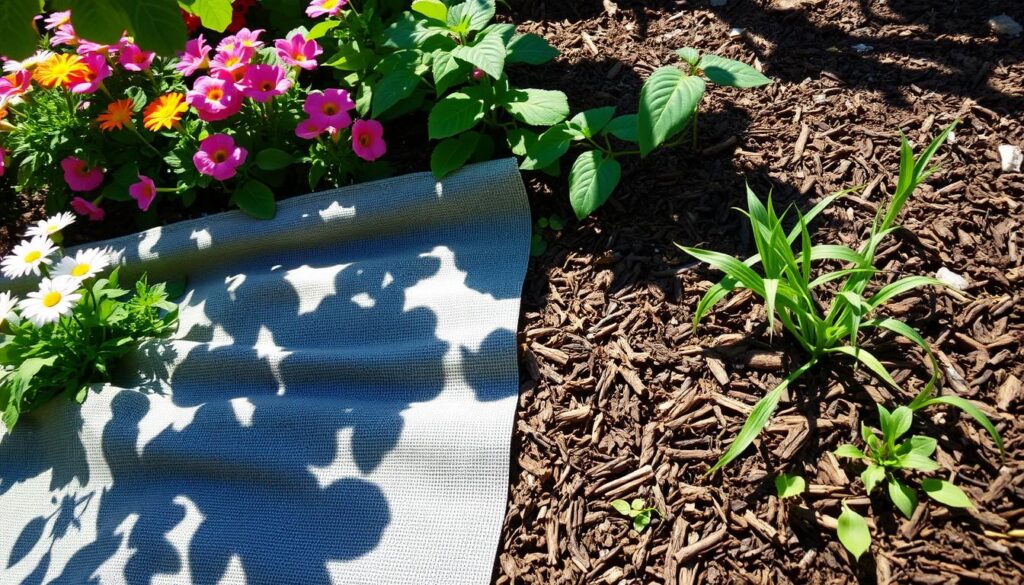
Alternatives for Weed Control Without Fabric
There are better ways to control weeds than just using fabric. Using a thick layer of organic mulch, 2-4 inches deep, can stop weeds from growing. This also helps the soil and plants by adding organic matter and helping fungi.
- Keep mulch deep by adding more every 4-5 years.
- Use shredded bark or other organic mulches for the best results.
- Check and control weeds with regular care instead of synthetic barriers.
Learning about the limits of landscaping fabric and trying other weed control methods can make gardening better. It helps your garden stay healthy.
Impact of Landscaping Fabric on Soil Health
Using landscaping fabric affects soil health, especially on microorganisms and earthworms. These creatures are key to a healthy soil ecosystem. Knowing how they work with the soil helps me choose better for my landscaping.
Importance of Microorganisms and Earthworms
Microorganisms and earthworms boost soil health. They help with nutrient cycling, aeration, and breaking down organic matter. But, landscaping fabric can block these helpers, stopping them from making the soil healthy.
These tiny helpers do more than just add nutrients. They keep the soil balanced and strong.
Effects of Fabric on Nutrient Transfer
Landscaping fabric can stop nutrients from moving from decaying materials to the soil. Over time, it traps dirt, making it less breathable. This can lead to plants lacking the nutrients they need for growth.
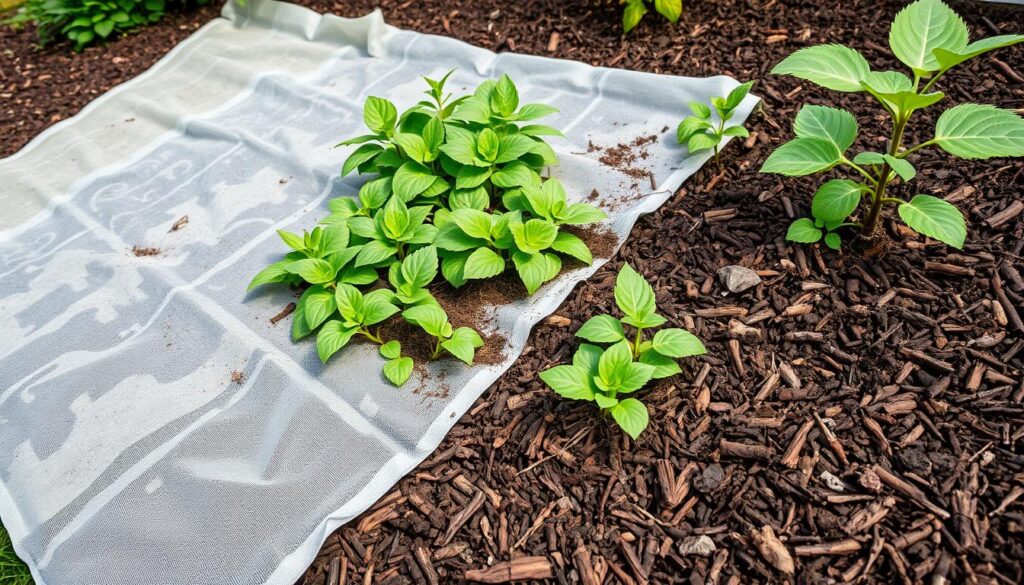
| Aspect | Positive Effects | Negative Effects |
|---|---|---|
| Soil Aeration | Promotes healthy root growth | Compacts soil, inhibiting air movement |
| Nutrient Cycling | Allows for effective nutrient transfer | Blocks nutrients from reaching plant roots |
| Diversity of Organisms | Enhances biodiversity in soil | Reduces populations of earthworms and microorganisms |
Best Practices for Mulching Without Fabric
Mulching is key to a healthy and beautiful garden. Not using fabric mulch can greatly improve your landscaping. Knowing the right mulch depth and when to reapply it helps your plants do well. Here are important tips to keep in mind.
Choosing the Right Mulch Depth
Finding the right mulch depth is crucial. I suggest:
- 1 to 2 inches for perennial beds
- 3 inches for trees and shrubs
This depth helps control weeds and keeps the soil moist. Too much mulch can cause rot and create “mulch volcanoes,” which are bad for plants.
When to Reapply Mulch for Optimal Health
Adding more mulch is key for plant health. I add an extra inch each year. This keeps nutrients flowing, maintains moisture, and fights weeds. The best time to do this is early spring, before plants start growing.
Following these tips keeps my garden looking great. Using the best mulching practices means my plants get what they need with less work. Here’s a quick guide:
| Practice | Recommendation |
|---|---|
| Mulch Depth | 1-2 inches for perennial beds; 3 inches for trees and shrubs |
| Reapply Mulch | Add 1 inch each year, ideally in early spring |
| Avoid | Creating mulch volcanoes and exceeding 2-3 inches of mulch |
Alternative Materials for Landscaping Projects
Looking into different landscaping materials can help with weed control and soil health. Cardboard and newspaper are great for making eco-friendly mulch. Adding compost and wood chips also brings many benefits to your garden.
Using Cardboard and Newspaper as Mulch
Cardboard mulch is a green choice instead of traditional fabrics. It stops weeds and makes the soil better as it breaks down. Here’s how I do it: I lay down cardboard or newspaper in layers. For newspaper, 4 to 8 layers work best. It’s a budget-friendly and earth-friendly option.
Benefits of Compost and Wood Chips
Compost is a big help for landscaping. It makes the soil better and gives plants what they need to grow. Wood chips are also good because they slowly break down, keep moisture in, and fight plant diseases. Both compost and wood chips are great for your soil, unlike traditional fabrics.
| Material | Advantages | Considerations |
|---|---|---|
| Cardboard | Biodegradable, suppresses weeds | Requires regular replacement |
| Newspaper | Inexpensive, effective as a weed barrier | Needs multiple layers for best results |
| Compost | Nutrient-rich, improves soil structure | Must be well-aerated to prevent odor |
| Wood Chips | Moisture retention, slow decomposition | May attract pests if not managed |
Using these alternative materials makes for a better garden. With cardboard mulch and compost, I can have a garden that’s good for plants and the planet.
When to Use Landscaping Fabric
Deciding when to use landscaping fabric can make a big difference in your landscaping projects. Knowing the best times to use it helps you keep your garden weed-free and soil healthy. Here are some situations where landscaping fabric is really helpful:
Best Situations for Fabric Use
Landscaping fabric is great under materials like gravel and rubber mulch. These materials help you not have to replace the mulch often and stop weeds from growing. Plus, the right fabric can make your garden look neat and tidy. Some top situations for using landscape fabric include:
- Under rock or gravel landscapes, promoting a clean and uniform look.
- In garden beds with shrubs, where effective weed control is crucial.
- For pathways and driveways, providing a stable base while preventing weed growth.
Alternatives to Consider: Gravel and Burlap
While landscaping fabric has its perks, it’s smart to think about other options for a healthy garden. Gravel is a top pick because it helps with drainage and stops weeds, and it looks good too. Burlap is another great choice. It lets soil health improve through organic breakdown, giving nutrients to your plants over time.
In conclusion, deciding when to use landscaping fabric needs careful thought about your landscaping goals. While it’s good at fighting weeds, looking into alternatives like gravel and burlap can lead to better soil health and sustainability.
Conclusion
Our exploration of landscaping fabric and mulch has shown their complex role in garden health. While landscaping fabric can help control weeds in paths, its use in planting beds has its downsides. These include overheating seedlings, allowing weeds to grow through, and degrading over time.
The choice of materials for landscaping greatly affects a garden’s sustainability and beauty. It’s important to think about soil health and how different mulches can help or hinder gardening success. I suggest trying cardboard or coarse wood chips for a lasting solution. Remember, no weed control method is perfect.
Keeping a garden healthy takes ongoing care and smart choices. For more on weed barrier fabrics, check out this resource. By choosing organic materials and efficient methods, we can create gardens that last.
FAQ
Can you put landscaping fabric over mulch?
Putting landscaping fabric over mulch is not usually a good idea. It can harm soil health and stop nutrients from getting to plants. This can lead to weaker plants and weed problems.
What are the benefits of using mulch?
Mulch helps keep soil moist and controls temperature. It also stops weeds and adds nutrients as it breaks down. Organic mulches like wood chips and pine straw are great for plants.
What are some alternatives to landscaping fabric for weed control?
Instead of fabric, try better mulch management, natural ground covers, or biodegradable options. Cardboard and newspaper can keep weeds down and improve soil quality over time.
How does landscaping fabric affect soil health?
Landscaping fabric can stop important microorganisms and earthworms from doing their job. These creatures help the soil breathe and get nutrients. Without them, the soil can’t get the nutrients it needs, hurting the ecosystem.
What is the best mulch depth for effective weed suppression?
For perennial beds, use 1 to 2 inches of mulch. Trees and shrubs need about 3 inches. The right amount of mulch keeps weeds away without blocking moisture from reaching the roots.
Are there situations where landscaping fabric is beneficial?
Yes, it’s good under materials like gravel and rubber mulch because it doesn’t need to be replaced often. But, think about the pros and cons before using it.
What are the advantages of using compost in landscaping?
Compost adds important nutrients to the soil, helps keep moisture in, and supports beneficial microbes. It acts as a natural mulch, fighting weeds, making it a key part of gardening.
Can I use plastic sheeting instead of landscaping fabric?
Plastic sheeting can stop weeds, but it also blocks water and air, hurting soil health. For better results, choose biodegradable or organic mulches.

